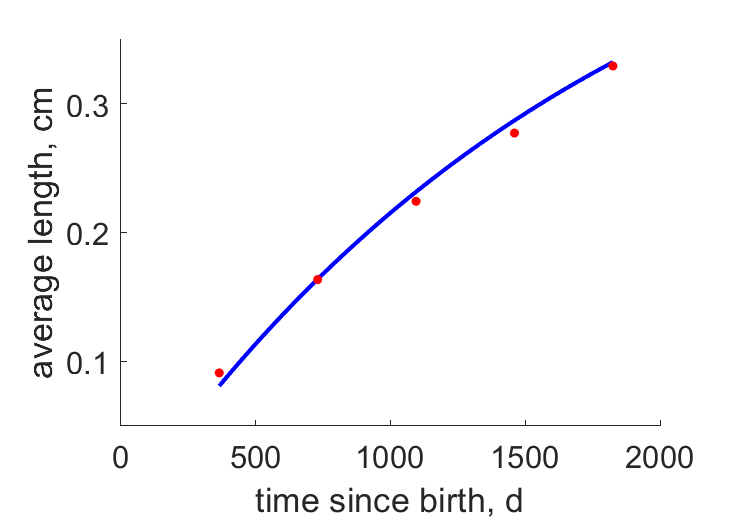Predictions & Data for this entry
| Model: abj | climate: MC, ME | migrate: | phylum: |
| COMPLETE = 1.5 | ecozone: MAN, MPE, MN | food: biPp, biAb | class: |
| MRE = 0.053 | habitat: 0jMp, jiMb | gender: D | order: |
| SMSE = 0.025 | embryo: Mp | reprod: O | family: |
Zero-variate data
| Data | Observed | Predicted | (RE) | Unit | Description | Reference |
|---|---|---|---|---|---|---|
| am | 2190 | 2190 | (1.905e-05) | d | life span | Dufo2017 |
| Lb | 0.0185 | 0.01858 | (0.004273) | cm | total length at birth | GiolDufo2015 |
| Lp | 0.28 | 0.2801 | (0.0003578) | cm | total length at puberty | Dufo2017 |
| Li | 0.514 | 0.5341 | (0.03911) | cm | ultimate total length | Dufo2017 |
| Wdi | 0.001882 | 0.001844 | (0.01994) | g | ultimate ash-free dry weight | Mari2017 |
| Ri | 6.137 | 6.142 | (0.0008921) | #/d | maximum reprod rate | guess |
Uni- and bivariate data
| Data | Figure | Independent variable | Dependent variable | (RE) | Reference |
|---|---|---|---|---|---|
| LWd |  | total length | ash-free dry weight | (0.3309) | Mari2017 |
| tL |  | time since birth | average length | (0.02819) | CollDufo2017 |
Pseudo-data at Tref = 20°C
| Data | Generalised animal | Thyasira cf gouldi | Unit | Description |
|---|---|---|---|---|
| v | 0.02 | 0.01993 | cm/d | energy conductance |
| p_M | 18 | 15.78 | J/d.cm^3 | vol-spec som maint |
| k_J | 0.002 | 0.002 | 1/d | maturity maint rate coefficient |
| k | 0.3 | 0.2985 | - | maintenance ratio |
| kap | 0.8 | 0.8823 | - | allocation fraction to soma |
| kap_G | 0.8 | 0.7995 | - | growth efficiency |
| kap_R | 0.95 | 0.95 | - | reproduction efficiency |
Discussion
- A minimal amount of information on Thyasira gouldi is used in this entry when there is no corresponding data for Thyasira cf. gouldi.
- Development and life history events: it is thought that Thyasira gouldi brood their eggs, which would undergo direct or abbreviated development.
- Growth measurements were updated in January 2018.
- T_typical is taken to be equal to the temperature of the sediment, which is seasonal (range 0.7-14C, LaurBats2015).
Facts
- Thyasirids may have sulfur-oxidizing bacterial symbionts. Symbiotic thyasirids are mixotrophs, deriving nutritional input from particulate feeding and from their symbionts. (Ref: DandSpir1993)
- Thyasira gouldi is a different species than Thyasira cf. gouldi (undescribed). (Ref: BatsLaur2014)
- Thyasira cf. gouldi forms a complex of cryptic species. This complex of species has been described as three Operational Taxonomic Units (OTUs) according to consistent differences in shell shape and gill filament morphology, as well as variability in nuclear and mitochondrial gene sequences. Two of the OTUs are symbiotic and closely related with each other while the third one is asymbiotic. This entry refers only to the symbiotic OTUs, which are considered together. (Ref: BatsLaur2014)
- Parathyasira sp. (which is asymbiotic) is sympatric with Thyasira cf. gouldi (including symbiotic OTUs). These thyasirids are found in close proximity and with a patchy distribution. (Ref: BatsLaur2014)
- Thyasira gouldi has been described as having a panarctic distribution; the distribution of Thyasira cf. gouldi (outside of Bonne Bay, Newfoundland) remains uncertain. (Ref: Dufo2017)
Bibliography